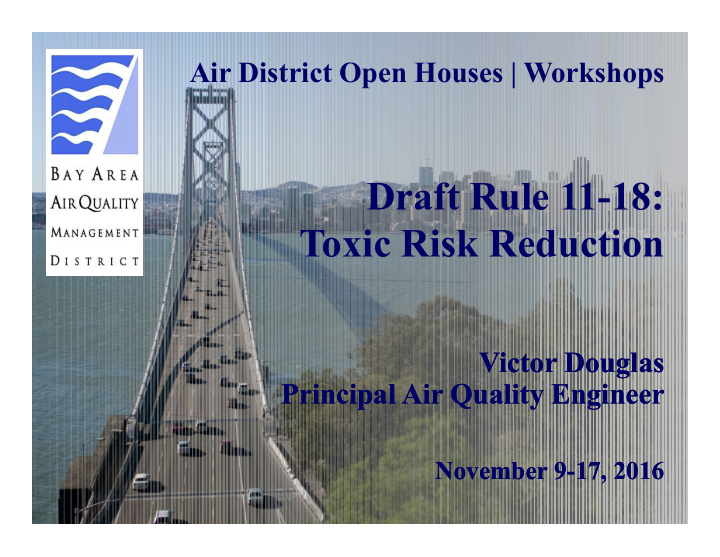



Air District Open Houses | Workshops Draft Rule 11-18: Toxic Risk Reduction Victor Douglas Victor Douglas Principal Air Quality Engineer Principal Air Quality Engineer November 9-17, 2016 November 9-17, 2016
Overview • Air Toxics Control Programs • Overview of Draft Rule 11-18 • Next Steps • Summary • Q & A
Control of Air Toxics Three Programs: 1. Toxic New Source Review Program 2. AB 2588 “Hot Spots” Program 3. Air Toxics Control Measures and Rules
Control of Air Toxics Toxics New Source Review Program • Prevents significant increases in health risks • Requires HRAs for new & modified sources of toxic emissions • Best Available Control Technology for Toxics for significant new or modified sources • Requires updated control for modified older, more highly polluting equipment
Control of Air Toxics AB 2588 “Hot Spots” Program • Enacted 1987 • Facilities report toxic emissions to Air District • Notify if risk exceeds threshold • Reduce risk if risk exceeds risk action level • Program is not sufficient – HRAs up to 20 years old – Diesel PM was not included – Does not reflect new health risk information – Does not consider background risks – Is not flexible
Control of Air Toxics Air Toxics Control Measures • > 30 source-specific rules affecting toxic emissions • National Emission Standards for Hazardous Air Pollutants (NESHAPs) • State Airborne Toxic Control Measures (ATCMs) • Air District Developed Measures and Rules
Control of Air Toxics Bay Area risk levels decline since 1990 4500 Others 4000 Lifetime Cancer Risk (chances per million) 1,3-butadiene 3500 benzene 3000 diesel PM 2500 2000 1500 1000 500 0 1990 2001 2014
Draft Rule 11-18 Reduce Health Risks to Lowest Achievable Levels • Benefits impacted areas • Incorporates latest health risk methodologies • Promotes continuous improvement • Ensures public transparency • Provides greater flexibility
Draft Rule 11-18 • Reduces facility risk action level from 100 in a million to 10 in a million • Incorporates new OEHHA Guidelines and health values • In the Bay Area facilities potentially affected include: - refineries - gas stations - hospitals - foundries - military facilities - landfills - crematoria - sewage treatment - chemical plants - data centers - schools / universities - power plants
Draft Rule 11-18 • Air District staff will conduct health risk assessments • Facilities above 10 in a million must: – Develop a risk reduction plan for Air District approval – Execute plan according to plan schedule • Risk reduction measures include: – Installation of B est A vailable R etrofit C ontrol T echnologies for T oxics (TBARCT) – Modification of operating hours and activity levels – Modification of emissions point characteristics
Draft Rule 11-18 Implementation Approach • Prioritize facilities • Conduct Health Risk Assessment (HRA) • Public Comment on HRA • Publish HRA results to BAAQMD website & email subscription list • Risk Reduction Plan – Publish requirement, submission and implementation status to BAAQMD website & email subscription list – 3-year implementation timeline – Could require faster implementation for CARE Communities
Draft Rule 11-18 Implementation Phases • Phase 1 (Prioritization Score > 250) – Health Risk Assessments (2017-2018) – Risk Reduction Plan development and approval (2018-2019) – Risk Reduction Plan implementation (2019-2022) • Phase 2 (Prioritization Score > 10) – Multiple-source facilities (2019-2025) • Phase 3 – Diesel internal combustion engines (2021-2027) • Phase 4 – Retail gas stations (2023-2028)
Next Steps • Continue meetings and presentations to interested groups • Form Technical Working Group—Early 2017 • Public Hearings—May 2017 – Publish for review and comment March 2017 – Proposed rule language – Staff Report – Socioeconomic Analysis – CEQA Environmental Impact Report
In Summary • Long history of controlling toxic emissions • Risk levels continue to decline – more work needed • Rule 11-18 would: – Reduce health risk to lowest levels feasible – Benefit impacted areas – Promote continuous improvement – Ensure public transparency – Provide greater flexibility – Phased Implementation – high risk facilities controlled first
Contact Information | Q&A Victor Douglas Principal Air Quality Engineer Rule Development Section vdouglas@baaqmd.gov (415) 749-4752
Recommend
More recommend